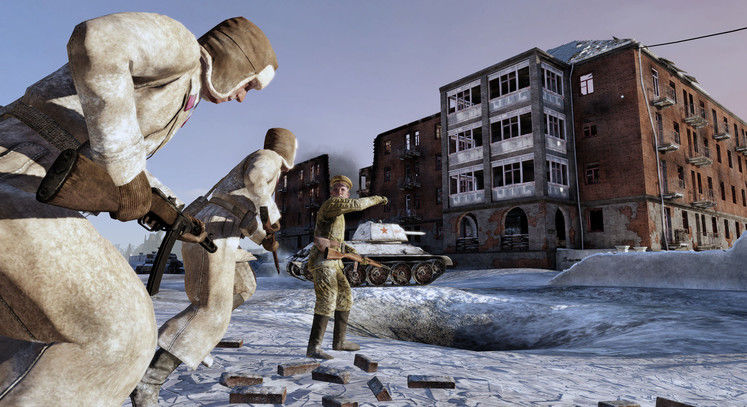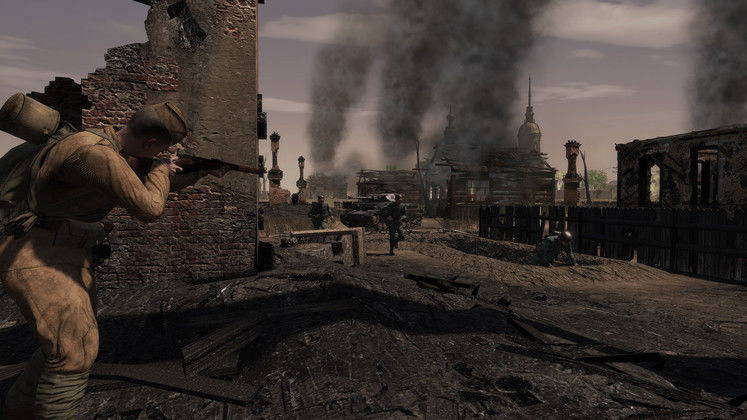But World War II is so yesterday, and gamers prefer their FPS’ to be set in more modern, ethically questionable spheres. Yet as Allied games developers marched victorious from the ruins of Berlin in search of warmer, more profitable climes, somebody forgot to tell Tripwire Interactive that the war for 1940’s Europe was over. And while other shooters swapped their MP40s for MP5s and their iron sights for ACOG scopes, Tripwire kept on the fight against Fascism, and have now emerged from Hitler’s crumbling bunker with what is probably the most meticulous WWII shooter ever made.
 |
| The Boxing-Day Sales reached new levels of hysteria |
For the uninitiated, here’s an easily digested summary of what Red Orchestra 2 is about. It’s a classical Guitar-Hero clone in which all the fake plastic instruments are coloured crimson. You need about fifty friends and an actual concert hall to play it properly. It’s rubbish.
Anybody? No? All right then. Outside of facetious critic land, it is a multiplayer focussed FPS which falls neatly between Call of Duty and theArmA games in terms of its approach towards the genre. The meat of the game comprises of various iterations of capture-and-hold scenarios on large maps that support up to sixty-four players, although there is also single-player that I will complain about in due course. I’ve heard it referred to as “hardcore”, although I would say uncompromising is a more accurate description.
As I’ve already mentioned, it’s also incredibly fastidious. If the devil is in the detail, then Red Orchestra 2 was developed by a team of exorcists. Take the humble Sniper Rifle. At a glance it looks like any other WWII sniper rifle, and indeed it shoots and kills like any other FPS sniper rifle. Then you realise you can hold your breath for a steadier aim. Ok, Call of Duty had that one. But then you notice you can adjust the optics to compensate for distant enemies, and you can quickly switch to iron sights nestled beneath the optical sight if your opponent is too close. And then you observe your character reloading with a full clip if the gun is empty, but individual bullets if the clip is half-full.
Now imagine that level of detail when applied to a tank. Yeah, that, but better.
I’ll talk about the tanks in more detail later. For now, you’re probably thinking such dedication to detail makes the game clunky and slow. Well actually it doesn’t, because the game stresses authenticity rather than realism. The attention to detail is all part of recreating the feel of fighting in Stalingrad. That being the case, for every tactical assault and carefully thought-out defensive strategy there’s a tooth-and-nail hand-to-hand scrap and a frantic forward charge while artillery pummels the ground around you.
The commitment to authenticity is visible in a more general sense too. The audio-visual feedback is arguably the best I’ve experienced outside of the Battlefield series. All the rifles (and there are many) have a kick like a Shaolin ostrich, and the way sound echoes both inside and outdoors is astonishingly lifelike. Although Bad Company 2 perhaps just edges Red Orchestra 2 in terms of the quality of sound engineering, the latter is a far more atmospheric experience.
 |
| “There’s a spider on your jacket. I’ll get it” |
Whereas in Battlefield you’re bombarded with explosions to the point of desensitisation, in Red Orchestra the distant rattle of a lone machinegun is a worrying sound, and the incoming wail of an artillery barrage will have you crying behind whatever little chunk of cover you can scramble to before the shells fall.
Speaking of cover, Red Orchestra 2 employs a first-person cover-system, which is unique in that it actually works. Pressing CTRL throws your shoulder against whatever broken bit of Stalingrad is between you and a surplus orifice, left-mouse allows you to blind-fire over said cover, and right mouse allows you to pop-out and aim. You can also use the arrow keys to quickly look around without aiming. Heck, the game even allows you to ignore the system entirely and use Q and E to lean. The only problem is that the cover button is also used to pick stuff up, which can be a real pig if somebody dies next to a wall and you want to steal their grenades.
The maps are all large and varied, some set at night, others in day, some summer, some winter. Pleasingly, uniforms vary depending on what time of year it is, with soldiers donning heavy white coats during the harsh Russian winter. My favourite map was Pavlov’s House, which also featured in the original Call of Duty. Here though, the sheer immensity of the apartment block really hits you, and the crumbling, labyrinthine interior fills you with dread if you’re unfortunate enough to be assaulting it. It makes you realise how thirty Russian soldiers could feasibly hold off the entire weight of the German army for two months, and why it was classed as a fortress on German maps at the time.
I also enjoyed any map that involved a tank, simply because Red Orchestra 2 features the best tanks in a game ever. They are hulking, claustrophobic things controlled entirely in first person, with four positions which can be taken by players; driver, commander, main gunner and secondary gunner. Almost everything in the tank works as it would in real life, from the hatches on the roof to the instruments beside the driver. What’s more, if a crewmember such as your main gunner is killed in the middle of a firefight, you have to crawl through the tank’s blood-spattered interior in order to take their place, which significantly ramps up the tension.
Two other things of note are the Squad-Leader and Commander classes. The Squad-Leader comes equipped with smoke grenades and the ability to give orders, his primary job being to help keep other soldiers alive. The Commander, however, has access to radios dotted around the map, and can call in reconnaissance planes, force reinforcements and best of all, order targeted artillery and mortar strikes. Personally, I found the Commander a rather fiddly class to play as, although the singleplayer does its best to teach you how to use him.
Yes, the single-player. Hmm. This is where Red Orchestra 2 falls facedown in the snow. There are two campaigns, German and Russian. The German campaign acts as an extended tutorial on how to play the game. The Russian campaign acts mostly as an inverted repeat of the German campaign, which is disappointing. Furthermore it’s largely played out on multiplayer maps with AI that is dodgier than a Cockney selling wristwatches, strung loosely together with a few cut scenes which come complete with some questionable “Churman” and “Roosyan” voiceovers. It’s a shame, because a properly tailored single-player experience would have driven the game straight into classic territory.
 |
| And from that day, Vladimir was filled with a zealous hatred of smokers |
One other major issue is that the server browser is fundamentally broken. It works on launch, but if you disconnect from a chosen server or even refresh the list, suddenly it refuses to show any servers whatsoever, requiring a restart of the game. As you can probably imagine, this is more painful than a wasp sandwich, and desperately needs fixing.
Red Orchestra 2 is a mostly triumphant and surprisingly refreshing return to the FPS’ favourite setting. Although the single-player is rather lacking, the attention to detail and harrowing atmosphere make for some intense and gripping multiplayer battles.
A toss up between assaulting the dreaded Pavlov’s House and the massive tank battle at the Uran airfield.
RED ORCHESTRA 2: HEROES OF STALINGRAD VERDICT
Red Orchestra 2 is a mostly triumphant and surprisingly refreshing return to the FPS’ favourite setting. Although the single-player is rather lacking, the attention to detail and harrowing atmosphere make for some intense and gripping multiplayer battles.
TOP GAME MOMENT
A toss up between assaulting the dreaded Pavlov’s House and the massive tank battle at the Uran airfield.




